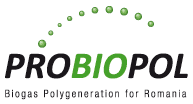
5. What is anaerobic digestion?
Anaerobic digestion is a purely bacterial process. The process works in the absence of air. The digestion process can be divided into four phases.
Phases of anerobic digestion
| Phase 0 | Phase 1 | Phase 2 | Phase 3 | Phase 4 |
| Input | Hydrolysis | Acidification | Acetofication | Methanogenesis |
| Carbohydrates | >Sugars | >Carbonic acids | >Acetic acid | >Methane |
| Fats | >Fatty acids | >Alcohols | >Hydrogen | >CO2 |
| Proteins | >Amino acids | >Hydrogen | >CO2 | |
| >CO2 | ||||
| >Ammonia |
In the first phase anaerobic bacteria use enzymes to decompose high molecular organic substances such as proteins, carbohydrates, cellulose and fats into low molecular compounds. During the second phase acid forming bacteria continue the decomposition process into organic acids, carbon dioxide, hydrogen sulphide and ammonia. Acid bacteria form acetate, carbon dioxide and hydrogen during the third phase, the acetogenesis. The fourth phase, the methanogenesi, involves methane forming bacteria producing methane, carbon dioxide and alkaline water.
The bacteria can digest any kind of biological material execpt solid biofuels with a high quantity of lignin, such as wood.
The bacteria in the methane phase need a longer reproduction time than the bacteria in the acid phase. Therefore the speed and scale of the fermentation depend on the metabolism of the methane bacteria. On the other hand the methane bacteria need the metabolism products from the acid bacteria. Thus, they are in symbiosis and the necessary conditions for both bacteria types are imperative for a smooth flow.
- What is biogas?
- Why is biogas sustainable?
- What are the potentials of biogas?
- What is industrial biogas polygeneration?
- What is anaerobic digestion?
- What is the standard process of biogas production?
- How is biogas used?
- What materials are fed into a biogas plant (input)?
- What kind of preliminary treatment do the substrates need?
- What kind of components does a biogas plant have?
- What kind of gas cleaning is necessary?
- What outputs does a biogas plant have?

